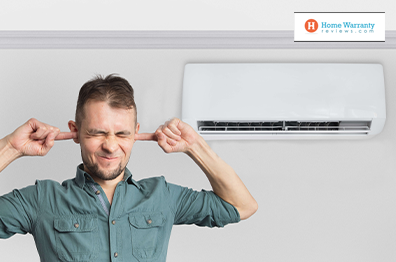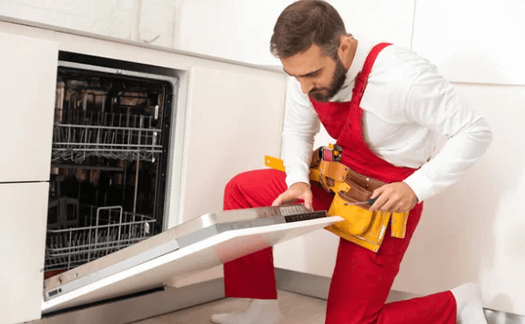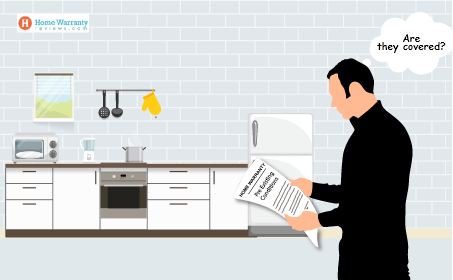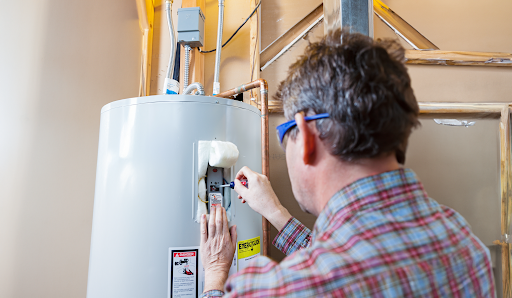 Last updated: April 18th, 2024
Last updated: April 18th, 2024
A Homeowner’s Guide To Why Garbage Disposals Hum & How to Fix Them
The garbage disposal, a modern marvel of kitchen convenience, can quickly become frustrating when it starts humming ominously instead of grinding efficiently. This unpleasant droning signifies a problem—the blades aren’t turning, and food waste isn’t being processed.
But before you resign yourself to a mountain of stinky dishes and a hefty plumber’s bill, take a deep breath! A humming garbage disposal is often a relatively simple fix; even homeowners with limited DIY experience can tackle the issue.
This article delves into the reasons behind garbage disposals humming, providing you with the knowledge to diagnose and potentially solve the problem yourself. Remember, even with a home warranty plan, these common disposal woes can relieve your time, money, and unnecessary frustration.
Understanding the Hum: Why Your Garbage Disposal Isn’t Grinding
When your disposal hums but doesn’t grind, it usually means the motor is getting electricity, but the blades are encountering resistance. Here are the leading culprits:
- Garbage Disposals Getting Clogged
- Overheating Motors
- Failing Motor Capacitor
- Tripped GFCI Outlet
- Faulty Impeller
Let’s look at how these issues create the garbage disposal humming sound and how it can be prevented.
1. Garbage Disposals Getting Clogged
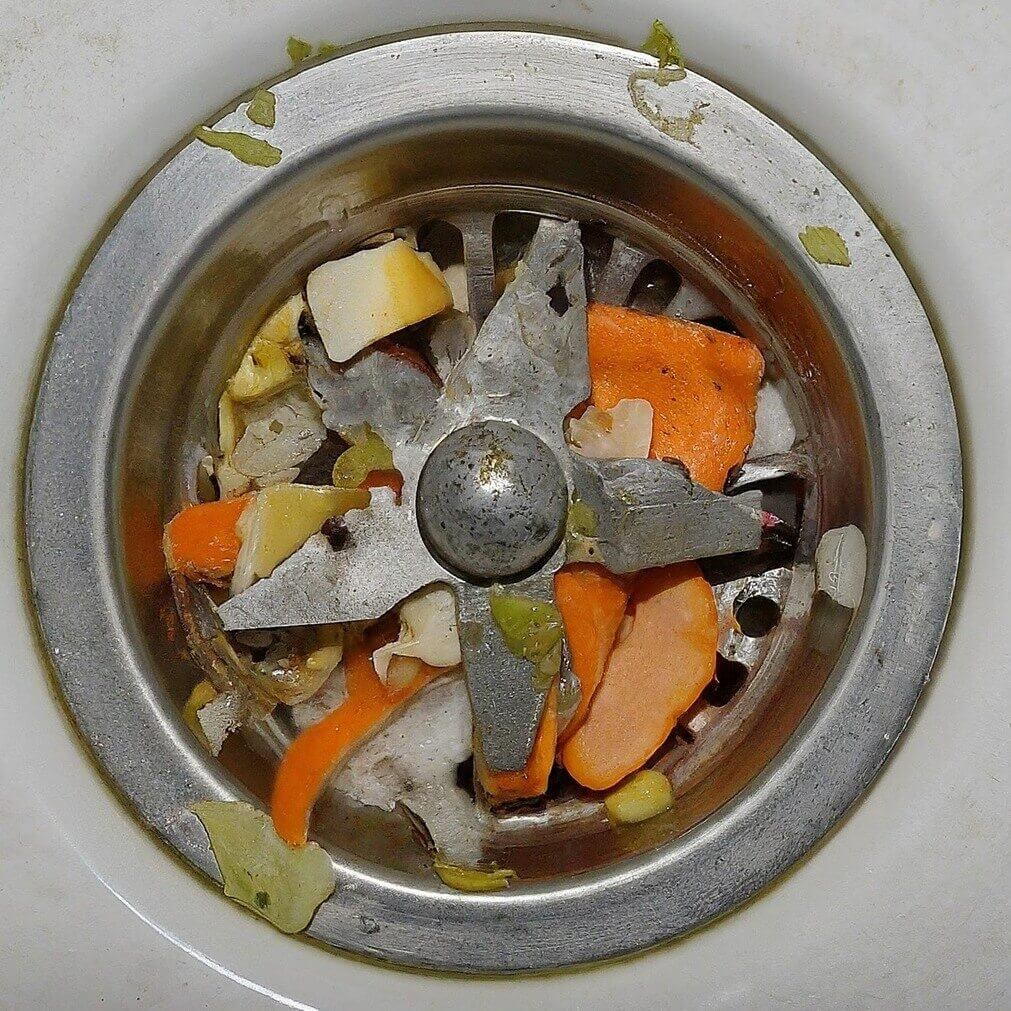
At the heart of garbage disposal lies a grinding chamber. This chamber houses a rotating impeller with sharp blades. The motor drives the impeller, which spins at high speeds, chopping food waste into tiny particles that can easily flow through the drain pipes.
Several factors can contribute to a clogged garbage disposal. Here’s a breakdown of the most common culprits and the reasons behind them:
- Fibrous & Stringy Materials: Cellulose fibers in vegetables like celery, corn husks, and artichokes are tough and stringy. These fibers can wrap around the disposal’s impeller shaft, hindering its rotation and causing food particles to accumulate.
- Starchy Foods: Starchy foods like potato peels and rice can form a sticky paste when combined with water. This paste can cling to the disposal blades and chamber walls, reducing grinding efficiency and creating an ideal environment for bacteria growth, leading to odors.
- Fats, Oils, & Grease (FOG): FOG solidifies as it cools down inside the disposal and drain pipes. This congealed fat acts like a glue trap, catching food scraps and creating a greasy buildup that restricts water flow and promotes bacterial growth.
- Non-Grindable Items: Certain items, such as coffee grounds, eggshells, fruit pits, and bones, are too hard or abrasive for disposal blades. These items can jam the impeller, damage the blades, and cause significant clogs.
- Improper Grinding Techniques: Putting too much food waste in the disposal at once can overload the motor and lead to incomplete grinding. Additionally, not running enough cold water while using the disposal allows food particles to clump together and potentially clog the drain.
The Clog Formation Process
The clogging process often starts with one of the culprits mentioned above. For example, fibrous materials like celery strings might initially wrap around the impeller shaft. This can trap other food scraps, creating a growing mass that restricts the disposal’s ability to grind effectively.
As FOG accumulates, it further exacerbates the problem by creating a sticky layer that attracts more debris.
The Consequences of Clogs
A clogged disposal can have several negative consequences:
- Reduced Grinding Efficiency: The clogged blades and restricted water flow prevent the disposal from properly grinding food waste, leading to slow drainage and potential overflows.
- Unpleasant Odors: Food trapped in the disposal decomposes, creating foul odors that can permeate your kitchen.
- Potential Damage: Severe clogs can strain the disposal motor and lead to overheating or even electrical damage.
How To Prevent Garbage Disposals From Clogging
Follow these steps to avoid the clogging of your garbage disposal and prolong its lifespan:
- Grind Only Approved Items: Always refer to your disposal’s manual for a list of approved food waste items. Avoid putting fibrous materials, starchy foods, FOG, and non-grindable items down the drain.
- Grind In Small Batches: Slowly feed food waste into the disposal, using cold running water to flush the particles down the drain.
- Regular Cleaning: Periodically grind up ice cubes and citrus peels to help sharpen the blades and deodorize the disposal. Additionally, consider using a commercial disposal cleaner to break down grease buildup.
How To Clean A Clogged Garbage Disposal?
You can clean your clogged garbage disposals using The Allen Wrench Method and The Pliers Approach.
The Allen Wrench Method
This method utilizes a special wrench that often comes included with the garbage disposal unit. Here’s how it works:
- The Allen Wrench: This wrench features a hexagonal-shaped head that fits perfectly into a corresponding socket on the underside of the disposal motor housing. This socket is connected directly to the impeller shaft, the central shaft that rotates the impeller blades.
- Manual Rotation: You can manually rotate the impeller shaft by inserting the Allen wrench into the socket and turning it back and forth. This rotation can dislodge food scraps that might be jammed and cause the clog.
- Direction of Rotation: Some disposal manuals recommend turning the wrench in a specific direction (clockwise or counter-clockwise) to avoid further jamming the clog. Consult your disposal’s manual for specific instructions.
- Limited Reach: The Allen wrench method can only dislodge clogs near the impeller blades. It might not be effective for deeper clogs within the drain pipes.
The Pliers Approach
This method uses pliers to remove visible obstructions from the disposal chamber. Here’s a breakdown of the technical aspects:
- Reaching the Clog: Carefully reach the disposal chamber through the drain opening using a pair of long-nosed pliers.
- Grasping the Obstruction: If you see a visible object causing the clog, such as a utensil or large food waste, use the pliers to grasp it firmly.
- Gently Removing the Obstruction: Slowly and carefully pull the object out of the disposal chamber. Never yank or pull forcefully, as this could damage the disposal components.
- Safety First: Only use pliers if you see the object causing the clog. Reaching blindly into the disposal can be dangerous.
- Don’t Force It: If the object is lodged tightly, don’t try to pry it out excessively. This could damage the disposal blades or loosen internal components.
2. Garbage Disposal Hums Caused By Overheating Motors
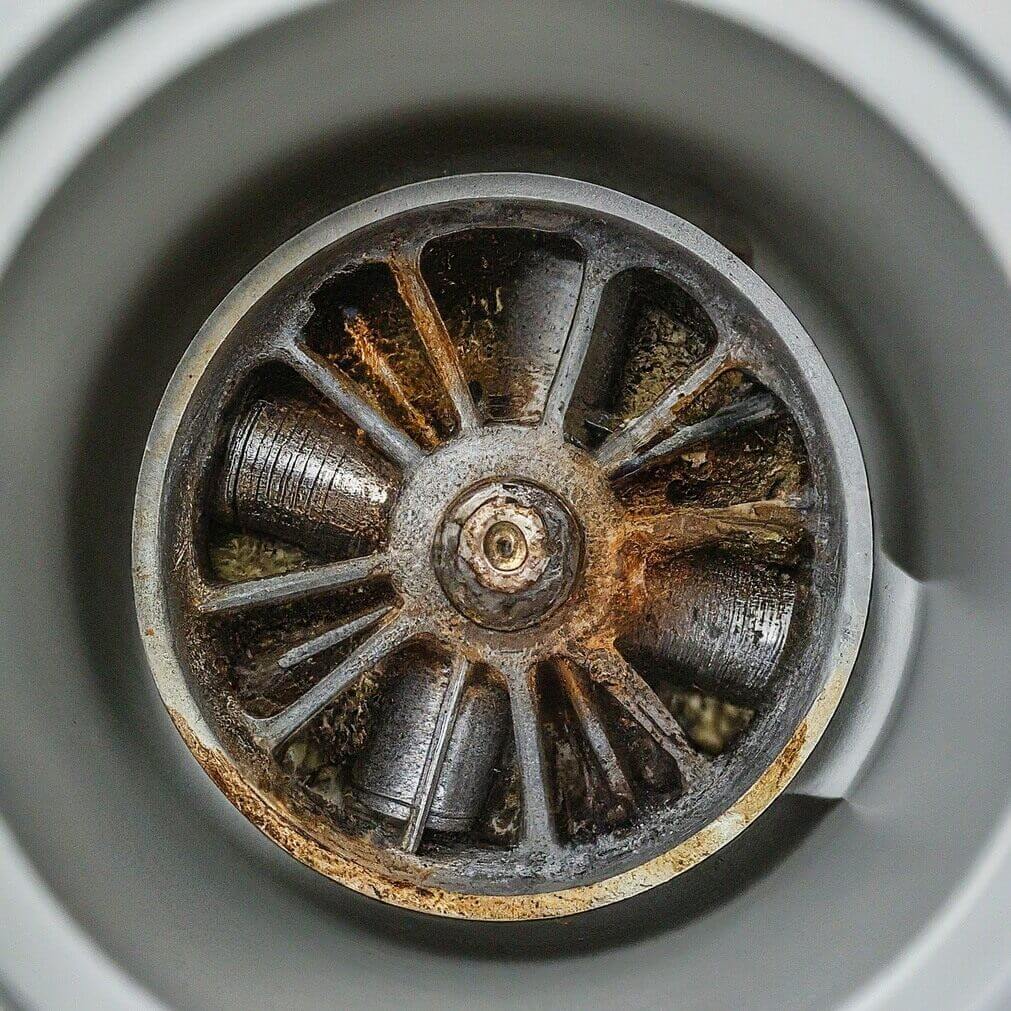
At the heart of garbage disposal lies a powerful electric motor. This motor drives the impeller, the rotating blade assembly that grinds food waste. The motor typically consists of a stator (stationary) and a rotor (rotating) component.
The stator houses electromagnets that generate a rotating magnetic field. This field interacts with the rotor, which contains conductive windings, creating torque that spins the impeller.
Heat Generation and Dissipation
During operation, the motor naturally generates heat due to electrical resistance within the windings and friction in the bearings. This heat buildup is normal to a certain extent. However, several factors can contribute to excessive heat generation in a garbage disposal motor:
- Overloading: Putting too much food waste into the disposal immediately forces the motor to work harder than intended. This increased workload leads to higher electrical currents and greater heat generation.
- Dull Blades: The disposal blades can become dull from wear and tear. Dull blades require more motor power to grind food waste effectively, leading to increased heat generation.
- Jammed Impeller: If a foreign object becomes lodged in the disposal, it can jam the impeller, preventing it from rotating freely. This situation forces the motor to work against resistance, causing heat buildup.
- Improper Grinding Practices: Not running enough cold water while using the disposal can allow food particles to clump together and put additional strain on the motor, leading to overheating.
The Perils of Overheating
When the motor temperature exceeds its safe operating limits, several issues can arise:
- Thermal Overload Protection: Most garbage disposals have built-in thermal overload protection. If the motor gets too hot, this safety feature automatically shuts down the disposal to prevent permanent damage. This explains why a humming sound might replace the grinding noise – the motor is receiving power but can’t function due to excessive heat.
- Reduced Motor Efficiency: Overheating can damage the motor’s windings and bearings, decreasing efficiency. This translates to a weaker motor that struggles to grind food waste effectively, even without overloading.
- Complete Motor Failure: In severe cases, prolonged overheating can lead to complete motor failure. This scenario necessitates a costly replacement of the entire garbage disposal unit.
Preventing Motor Overheating
By understanding the causes of overheating, you can take steps to prevent it:
- Sharpen The Blades: Periodically grind ice cubes or eggshells (if your disposal manual allows) to help sharpen the blades and reduce the motor’s workload.
- Use Plenty Of Cold Water: Run cold water while using the disposal and for a few seconds after to flush food particles down the drain and keep the motor cool.
- Avoid Grinding Non-Approved Items: Never put hard or abrasive materials like bones, coffee grounds, or fruit pits down the disposal, as these can jam the impeller and strain the motor.
3. Humming Issue Stemming From Failing Motor Capacitor
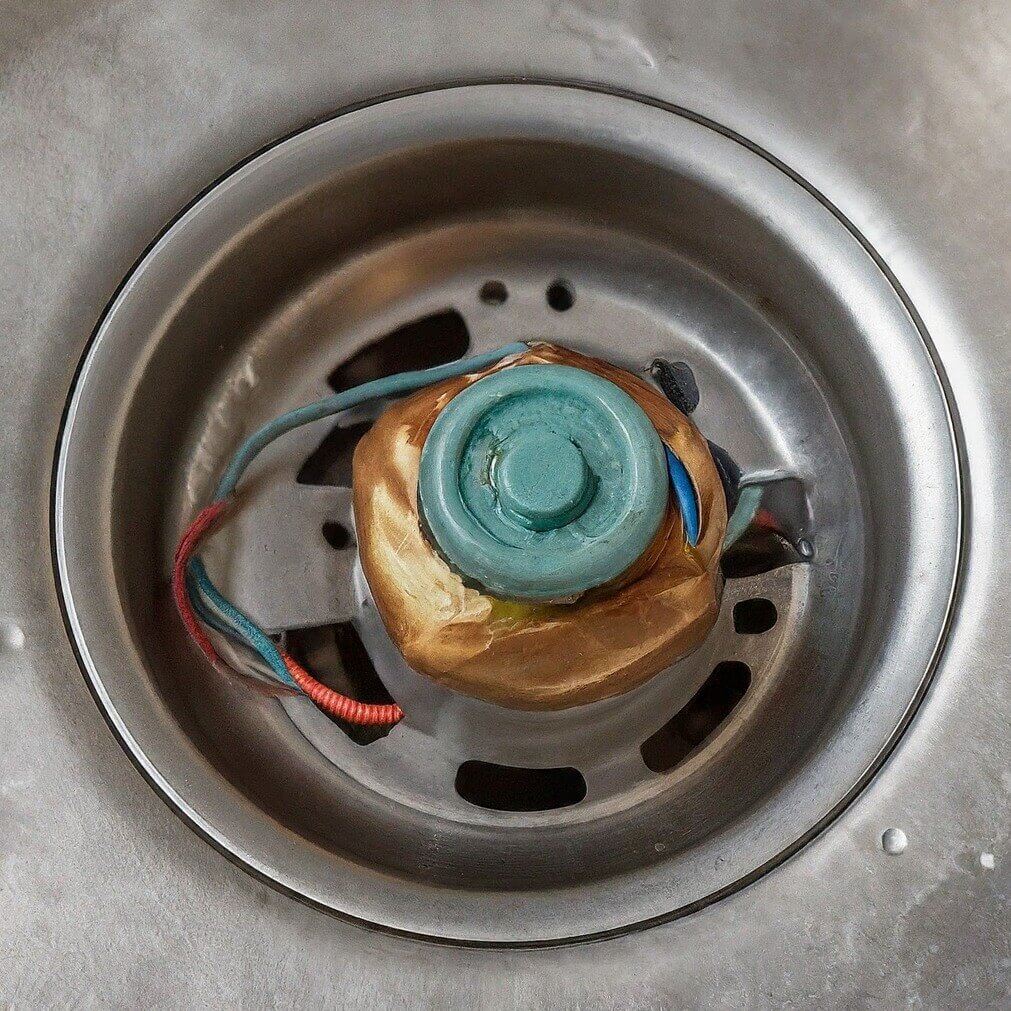
The motor capacitor acts as a temporary storage unit for electrical energy. During startup, the capacitor provides a current surge to the motor windings, helping them overcome their initial resistance and begin rotating. Once the motor reaches its running speed, the capacitor continues to regulate current flow to the windings, optimizing motor efficiency.
How A Failing Capacitor Creates A Hum
As a capacitor ages or malfunctions, its ability to store and deliver electrical energy diminishes. This decline can manifest in several ways that can lead to a garbage disposal humming:
- Reduced Starting Torque: A failing capacitor might not provide enough initial surge current to the motor windings. This can cause the motor to struggle to start, potentially leading to a humming sound and difficulty spinning the impeller blades.
- Inefficient Power Delivery: An impaired capacitor can disrupt the smooth flow of current to the motor windings during operation. This inefficiency can cause the motor to run unevenly or erratically, potentially resulting in a garbage disposal buzzing sound.
- Overheating Motor: Due to the inefficiency caused by the failing capacitor, the motor might have to work harder to maintain speed. This increased workload can lead to overheating, and as a safety measure, the disposal might hum but not grind to prevent permanent motor damage.
Diagnosing a Failing Capacitor
Unfortunately, diagnosing a failing capacitor specifically can be challenging without the help of a qualified electrician. However, some signs might suggest a motor issue in general:
- Humming Sound With No Grinding: This is the most common symptom.
- Burning Smell: A burning odor from the disposal can indicate overheating due to a motor issue.
- Intermittent Operation: The disposal might start and stop erratically.
4. Tripped GFCI Outlet Creating The Noise
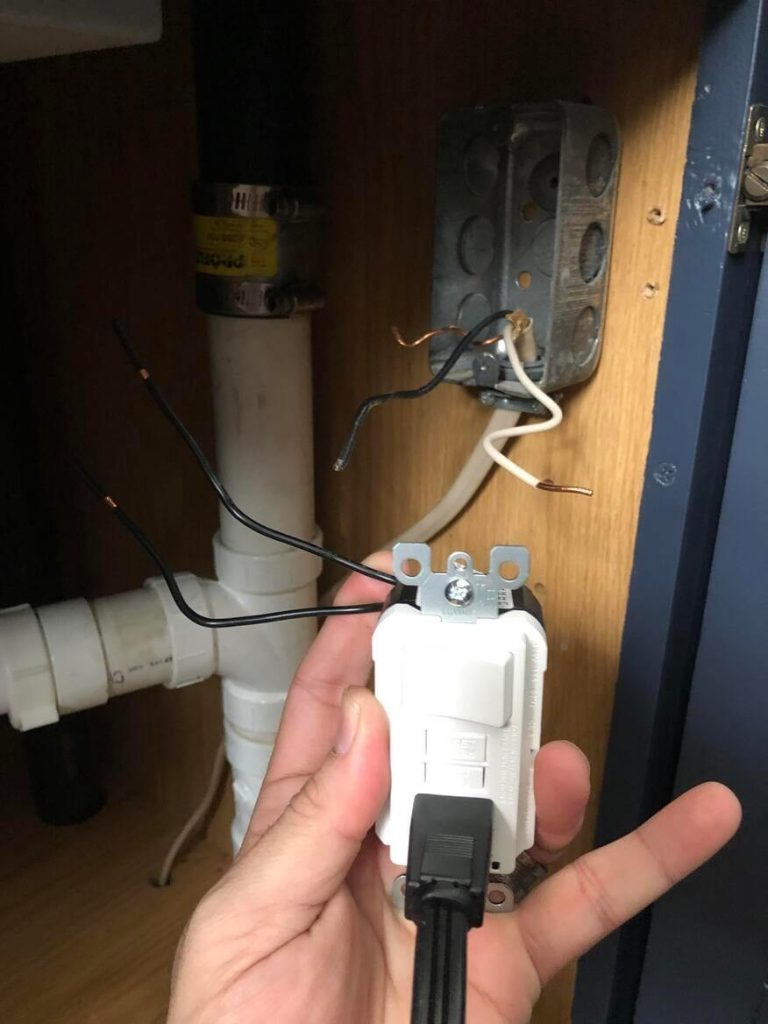
GFCI outlets are vital safety features commonly found in kitchens and bathrooms. They continuously monitor the electrical current flowing between the hot and neutral wires in a circuit. In normal operation, the amount of current flowing out on the hot wire should equal the amount of current returning on the neutral wire.
However, the current flow becomes unbalanced if there’s a ground fault where electricity leaks from the hot wire to the ground (through water or a faulty appliance). This imbalance triggers the GFCI outlet to instantly shut off power to the circuit, preventing severe electrical shocks.
The Connection Between GFCI Outlets and Garbage Disposals
Many garbage disposals are wired to GFCI outlets. This safety measure ensures that if a fault occurs within the disposal itself, the GFCI will trip, preventing potential electrical hazards.
The Humming Scenario
When a GFCI outlet trips due to a ground fault, it cuts power to the garbage disposal entirely. However, sometimes, a minor ground fault or a surge in current can cause the GFCI to interrupt the power flow and then reset itself momentarily.
This rapid on-and-off cycle can manifest as a humming sound from the disposal motor. The motor might attempt to start but cannot sustain operation due to the power interruption.
Identifying a Tripped GFCI Outlet
GFCI outlets have a “Test” and a “Reset” button. Here’s how to identify a tripped GFCI:
- Locate the GFCI outlet near your kitchen sink. It will typically have the labels “Test” and “Reset.”
- Press the “Test” button. If the outlet functions correctly, it will trip, and the “Reset” button will pop out.
- Press the “Reset” button firmly if it’s popped out. This should restore power to the outlet.
If pressing the “Reset” button doesn’t solve the problem, or if the GFCI trips frequently, it’s crucial to call a qualified electrician. This could indicate a more serious electrical issue that needs professional attention to ensure safety.
Preventing GFCI Trips
While GFCI trips are a safety feature, here are some ways to minimize their occurrence:
- Avoid Overloading The Circuit: Don’t use multiple high-powered appliances on the same circuit as your garbage disposal.
- Keep The Disposal Area Dry: Moisture around the disposal or outlet can increase the risk of a ground fault.
- Use The Disposal Properly: Avoid putting excessive food waste or inappropriate items down the drain, which can strain the motor and lead to electrical issues.
5. Humming Noise Coming From A Faulty Impeller
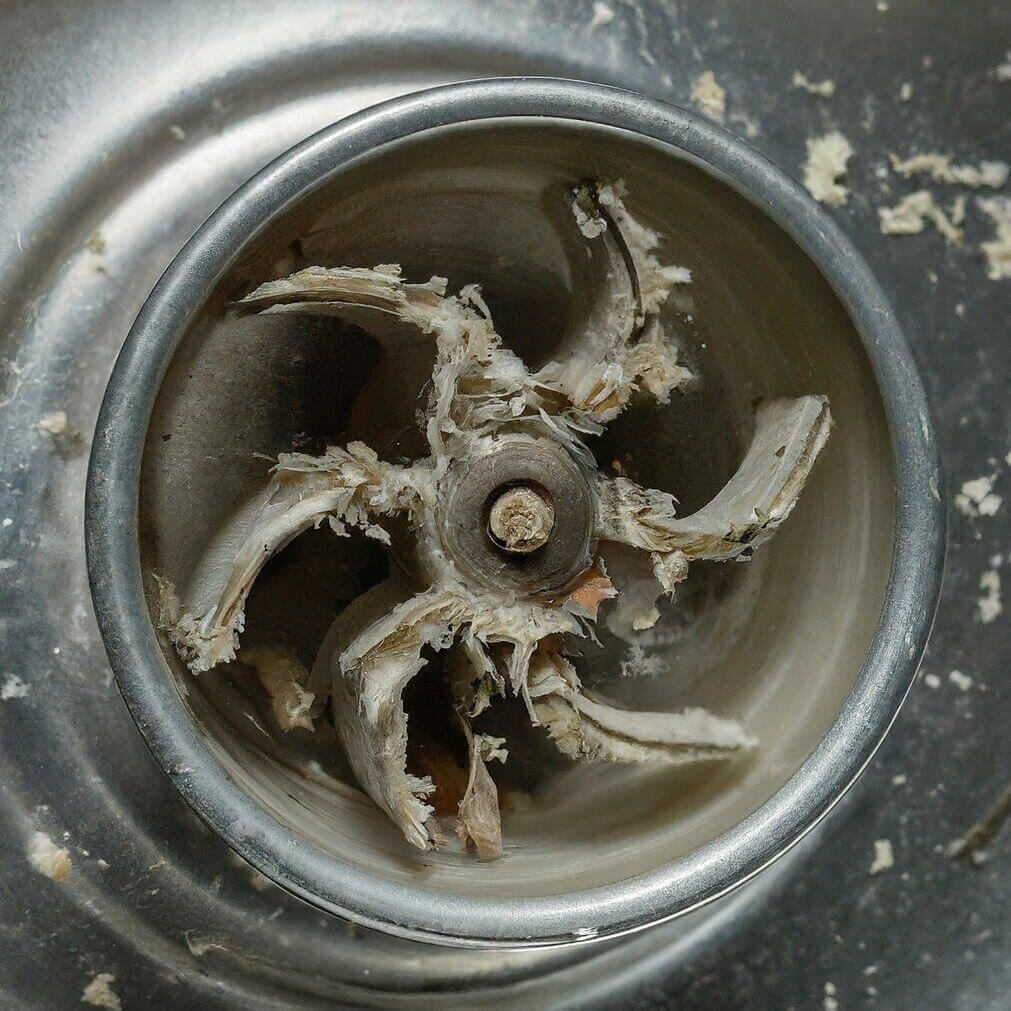
The impeller is a crucial component within the disposal unit. It typically consists of a central hub connected to radiating arms that hold sharp blades at their tips. The motor shaft connects to the central hub, and as the motor spins, it transfers rotational force to the impeller, causing the blades to spin rapidly.
The Grinding Process
As food waste enters the disposal chamber, the spinning impeller blades contact the scraps. The sharp blades tear and chop the food waste into smaller particles that can easily flow through the drain pipes. The force of the spinning impeller also helps propel the food waste down the drain.
How a Faulty Impeller Creates a Hum
There are several ways a faulty impeller can lead to a humming disposal:
- Dull Blades: The impeller blades can become dull over time due to wear and tear from grinding food waste. Dull blades require more motor power to function effectively. This increased strain on the motor can manifest as a humming sound, especially when grinding tougher food scraps.
- Damaged Blades: The impeller’s blades can become chipped, bent, or even break off entirely due to wear and tear, corrosion, or putting hard objects down the drain. Damaged blades significantly reduce the impeller’s grinding efficiency. The motor might still attempt to spin the impeller, but the lack of proper cutting edges leads to a humming sound and minimal grinding.
- Loose Impeller Shaft: The impeller shaft connects the motor to the impeller itself. Over time, the connection between the shaft and the impeller can loosen. This loose connection can cause the impeller to wobble or spin erratically, straining the motor and potentially leading to a humming sound.
- Broken Impeller: In severe cases, the impeller can break due to excessive stress or a manufacturing defect. A broken impeller won’t spin, but the motor might still attempt to rotate it, resulting in a disposal making humming noise without any grinding action.
Diagnosing A Faulty Impeller
Unfortunately, visually inspecting the impeller for damage often requires disassembling the disposal unit, which is not recommended for safety reasons. However, some signs can indicate a potential impeller issue:
- Humming Sound With Minimal Or No Grinding: This is the most common symptom.
- Unusual Noises: Grinding noises that sound metallic or clanging could suggest damaged blades.
- Burning Smell: A burning odor from the disposal can indicate the motor overheating due to excessive strain from a faulty impeller.
What To Do When You Suspect A Faulty Impeller
If you suspect a faulty impeller, it’s crucial to prioritize safety:
- Unplug the disposal or turn off the power at the breaker box
- Do not attempt to disassemble the disposal yourself
- A qualified plumber can diagnose the specific cause of the humming and determine the best course of action.
Preventative Tips To Avoid Garbage Disposal Humming
A well-functioning garbage disposal is a quiet kitchen essential. But that familiar whirring sound can become a concerning hum when trouble breeds. To prevent the frustration of a garbage disposal buzzing, here are some key preventative tips:
- Portion Control: Don’t overload the disposal. Grind food waste in small batches with plenty of cold running water to avoid jamming and straining the motor.
- Know Your Limits: Only put approved food scraps down the drain. Avoid grinding bones, coffee grounds, fruit pits, or excessive grease, as these can dull blades, clog pipes, and overwork the motor.
- Regular Grinding: Run the disposal occasionally with cold water and ice cubes to help keep the blades sharp and prevent food waste buildup.
- Baking Soda and Vinegar: Once a month, pour a half cup of baking soda and a cup of vinegar down the drain. The fizzing action can help loosen any grease or debris buildup.
- Unusual Noises: Be mindful of any unusual grinding noises from the disposal. Grinding noises that sound metallic or clanging could suggest damaged blades that need attention.
- Burning Odor: A burning odor from the disposal can indicate overheating due to a motor issue. If you smell burning, turn off the disposal immediately.
- Reset Button: If your garbage disposal hums and won’t grind, try pressing the reset button on the unit’s underside. This might resolve a temporary issue.
When in Doubt, Unplug: If the disposal continues to hum or exhibits any concerning behavior, unplug it or turn off the power at the breaker box before attempting any troubleshooting.
Why Should Home Warranty Plan Owners Learn About The Humming Issue?
Even with a home warranty plan, understanding how garbage disposal clogs happen empowers home warranty owners in several ways:
- Save Money On Service Calls: Clogged disposals are homeowners’ most common plumbing issues. By knowing what causes clogs and how to potentially fix them yourself (using the methods mentioned previously, like removing objects with pliers or using an Allen wrench), you can avoid a service call fee often associated with home warranty plans.
- Faster Kitchen Recovery: A clogged disposal can stop your food prep. If you can diagnose and fix a simple clog, you can get your kitchen back in action much quicker than waiting for a technician’s availability. This can be especially helpful when you need a functioning sink for upcoming meals or cleaning.
- Prevent Future Problems: Understanding what can cause a disposal to clog allows you to adjust your disposal habits. This can include avoiding putting certain food items down the drain and using proper grinding techniques. By preventing future clogs, you can minimize the need for warranty repairs and save money in the long run.
- Informed Warranty Calls: While some fixes are DIY-friendly, there can be more complex reasons for clogged disposal that might not be readily apparent. For instance, a deep clog requiring a disposal auger or a clog caused by a faulty disposal unit would likely necessitate a call to your home warranty provider.
However, by understanding the issue, you can better communicate the problem to your warranty provider and determine if a technician’s visit is necessary. You can explain the troubleshooting steps you’ve already taken and the symptoms you’re experiencing, allowing the provider to make a more informed decision about dispatching a technician.
Top Home Warranty Companies Covering Garbage Disposal
Here are some of the top home warranty companies in the United States that are known to cover garbage disposal repair or replacement in their plans:
|
Company |
Covered Parts |
Exclusion |
Maximum Coverage |
Service Call Fee |
Turnaround Time |
|
|
All parts and components are covered |
NA |
Up to $4,000 (for the platinum plan & $2,000 for the gold plan) for all appliances |
$100 & $125 |
Within 48 hours to schedule the diagnosis appointment under normal circumstances |
||
|
All components, including motors, blades, wiring, casing, switches, and leaks due a mechanical failure |
malfunctions caused by bones, glass, or foreign objects other than food |
$500 per year for garbage disposal |
$70 & $150 (on weekends/after hours) |
Within 24-48 hours after receiving the service request |
||
|
All components and parts |
NA |
$3,000 per 12-month period for each Covered Item for access, diagnosis, and repair or replacement for all appliances |
$75 – $125 |
Within 4 hours. In some circumstances, it could take more than 48 hours for a Service Provider to accept the request |
||
|
All components and parts, including the entire unit |
Failures and/or jams caused by bones, eggshells; glass, or foreign objects other than food |
$1,500 per contract item for access, diagnosis, repair, and/or replacement for all appliances |
$75 |
Within two (2) days during normal business hours and four (4) days on weekends and holidays after you request service |
||
|
All mechanical components and parts |
Malfunction caused by bones, glass, or foreign objects other than food |
Up to $2,000 per covered item for all appliances |
$90 |
Within 48 hours |
Final Words
This guide has equipped you to troubleshoot the most likely culprits, from simple clogs to electrical issues. Remember, the Allen Wrench or Pliers method might be your hero for minor clogs. But for electrical problems or persistent humming, call in a plumbing or electrical professional. By following these tips and practicing preventative maintenance, you can keep your disposal humming happily – the quiet way!
related articles
 Home Warranty 101: How Does A Home Warranty Work And What Should You Know About Them
Home Warranty 101: How Does A Home Warranty Work And What Should You Know About Them









